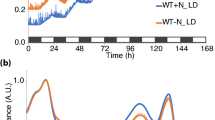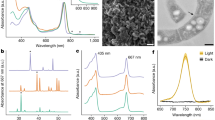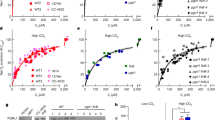Abstract
PROFOUND differences in structure and function separate the prokaryotic cyanobacteria (blue-green algae) from eukaryotic algae and plants, whereas oxygenic photosynthesis is considered to distinguish the cyanobacteria and eukaryotic plants from the other phototrophic bacteria. The prevailing concepts on the cyanobacteria emphasise their prokaryotic nature and oxygenic photosynthesis. This combination of properties, among others, led to the suggestion that the cyanobacteria represent a group of possible progenitors of chloroplasts1. While cyanobacteria typically exhibit oxygenic photosynthesis with two photosystems using electrons from water, it has been demonstrated that photosystem I of certain cyanobacteria can function in vivo independently in supporting virus production2, heterocyst functions3 and even photoheterotrophic growth4. We have demonstrated anoxygenic photosynthesis in a cyanobacterium Oscillatoria limnetica, also capable of oxygenic photosynthesis, which was isolated from the anaerobic H2S rich hypolimnion layer of the monomictic, hypersaline Solar Lake located on the desert margin of the Gulf of Elat, Israel5. During winter stratification, this layer is located below two plates of phototrophic sulphur bacteria (Chromatium violescens and Prosthecochloris sp.), and exhibits a dense cyanobacterial bloom with very high rates of primary production. We report here evidence for the photosystem I-driven CO2 photoassimilation in O. limnetica with H2S serving as sole electron donor through oxidation to elemental sulphur.
This is a preview of subscription content, access via your institution
Access options
Subscribe to this journal
Receive 51 print issues and online access
$199.00 per year
only $3.90 per issue
Buy this article
- Purchase on Springer Link
- Instant access to full article PDF
Prices may be subject to local taxes which are calculated during checkout
Similar content being viewed by others
References
Stanier, R. Y., in Organization and Control in Prokaryotic and Eukaryotic Cells, 1–38 (Soc. Gen. Microbiol, 1970).
Padan, E., Ginzburg, D., and Shilo, M., Virology, 40, 514–521 (1970).
Fay, P., in The Biology of Blue-green Algae (edit. by Carr, N. G., and Whitton, B. A.), 238–259 (Blackwell, Oxford, 1973).
Rippka, R., Archs Mikrobiol., 87, 93–98 (1972).
Cohen, Y., Padan, E., and Shilo, M., J. Bact. (in the press).
Pfennig, N., and Lippert, R. D., Archs Mikrobiol., 55, 245 (1966).
Gaffron, H., Biol. Rev., 19, 1–20 (1944).
Stewart, W. D. P., and Pearson, H. W., Proc. R. Soc., B 175, 293–311 (1970).
Lowry, O. H., Rosebrough, N. J., Farr, A. L., and Randall, R. J., J. biol. Chem., 193, 265–275 (1951).
Standard Methods for the Examination of Water and Wastewater, thirteenth ed. (American Public Health Association, American Water Work Association and Water Pollution Control Federation, 1971).
Jørgensen, B. B., and Fenchel, A. T., Mar. Biol., 24 189 (1974).
Author information
Authors and Affiliations
Rights and permissions
About this article
Cite this article
COHEN, Y., JØRGENSEN, B., PADAN, E. et al. Sulphide-dependent anoxygenic photosynthesis in the cyanobacterium Oscillatoria limnetica. Nature 257, 489–492 (1975). https://doi.org/10.1038/257489a0
Received:
Accepted:
Issue Date:
DOI: https://doi.org/10.1038/257489a0
This article is cited by
-
Combined effect of bicarbonate and water in photosynthetic oxygen evolution and carbon neutrality
Acta Geochimica (2023)
-
Modern brackish bryostromatolites (“bryoliths”) from Zeeland (Netherlands)
Palaeobiodiversity and Palaeoenvironments (2022)
-
Photosynthetic performance in cyanobacteria with increased sulphide tolerance: an analysis comparing wild-type and experimentally derived strains
Photosynthesis Research (2022)
-
Phycocyanin content and nutritional profile of Arthrospira platensis from Mexico: efficient extraction process and stability evaluation of phycocyanin
BMC Chemistry (2021)
-
Electrical conductivity as a driver of biological and geological spatial heterogeneity in the Puquios, Salar de Llamara, Atacama Desert, Chile
Scientific Reports (2021)
Comments
By submitting a comment you agree to abide by our Terms and Community Guidelines. If you find something abusive or that does not comply with our terms or guidelines please flag it as inappropriate.



